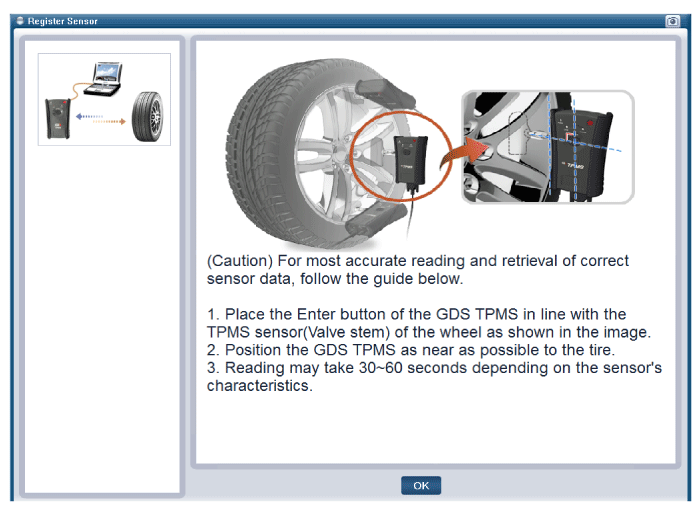Hyundai Genesis: Tire Pressure Monitoring System / TPMS Sensor Repair procedures
Hyundai Genesis (DH) 2013-2016 Service Manual / Suspension System / Tire Pressure Monitoring System / TPMS Sensor Repair procedures
| Removal |
| 1. |
Remove the valve core and deflate the tire. |
| 2. |
Remove the side of the tire bead area from the wheel using tire changing machine .
|
| 3. |
Rotate the wheel clockwise.
|
| 4. |
Must check whether the valve (air inlet portion of the
silver) deviates from its original location during transportation. Then
make sure that the valve (metal brackets) are assembled in the position
indented from the original location. |
| 5. |
Push the valve into the specified location (for metal
brackets to fit inside) in order to prevent the valve from deviating
from the specified location while being tightened. Apply the specified
torque (8Nm) and do not reuse the nut. |
| 6. |
Push the valve into the valve hole to ensure the seal washer contacts the rim.
|
| 7. |
Hold the housing with two fingers and use one finger to push the valve in the valve axial direction.
|
| 8. |
The laser marking in the housing must be visible.
|
| 9. |
When the valve is fully inserted so that the contact between
the sensor and the rim while keeping hands on the wheel nut tightening
will start Wed.
|
| 10. |
While maintaining the position of the valve and the sensor is mounted nut.
|
| 11. |
Apply tire soap or lubrication to the top and bottom tire beads.
|
| 12. |
To fit the bottom bead, position the sensor in the 5 o’clock direction from the head on the tire changing machine
|
| 13. |
Place the tire on the rim so the bottom bead touchesthe edge
of the rim behind the sensor (the 6 o’clock direction). Rotate the rim
clockwise, and push down on the tire at the 3 o’clock position to fit
bottom bead.
|
| 14. |
After bottom bead is on tire, rotate the rim until the sensor
isin the 5 o’clock direction from the head on the tire changing
machine. Push down on the tire at the 3 o’clock position and rotate
the rim clockwise to fit the top bead.
|
| 15. |
Inflate the tire until both beads are seated.
|
| 16. |
In the case of TPMS sensor failure, TPMS sensor needs
learning. Replace faulty sensors with new ones and conduct the learning
process of TPMS sensors. |
| Inspection |
Test procedures after installing TPMS sensor
| 1. |
The sealing washer should be compressed on the outside rim of the hole. |
| 2. |
The lower part of the valve should be located in a specified place (no metal brackets). |
| 3. |
The housing should contact at least one or more points of the rim surface. |
| 4. |
The rim of the housing mounting height shall not exceed the height of the chin.
|
Diagnosis procedure by using diagnostic device
As manual for diagnosis methods by using diagnosis device, the main contents are as follows:
| 1. |
Connect self-diagnosis connector(16pins) located the lower
part of driver side crash pad to self-diagnosis device, and then turn
the self-diagnosis device after key is ON. |
| 2. |
Select the "vehicle model" and "TPMS" on GDS vehicle selection screen, then select OK. |
| Diagnostic Procedure Using a Diagnostic Instrument |
The following section describes how to diagnose faults using a diagnostic instrument.
| 1. |
Connect the diagnostic instrument to the self-diagnostic
connector (16-pin) beneath the crash pad on the side of driver's seat,
and then turn on the ignition to activate the diagnostic instrument. |
| 2. |
In the GDS Vehicle Type Selection menu, select "Vehicle Type" and "TPMS" System, and then opt for "OK."
[Initial Screen for Sensor ID Registration]
[Register Sensor function description]
[Preparation phase sensor measurements]
[Sensor register method 1]
[Sensor register method 2]
[Sensor register method 3]
[Sensor register method 4]
[Sensor register method 5]
[Sensor Status initialization]
[Sensor function description]
[Preparation phase sensor measurements]
[Sensor measurements 1]
[Sensor measurements 2]
[Sensor Status]
|
 TPMS Sensor Description and Operation
TPMS Sensor Description and Operation
Description
1.
General description
WU is a sensor placed in the tire that reports pressure and temperature.
The WU is mounted inside the wheels, fixed to the valve. The angle between the valve ...
 TPMS Receiver Description and Operation
TPMS Receiver Description and Operation
Description
1.
Function
The TPMS monitors the pressure and temperature of the tires
and warns the driver of changes that could potentially influence driving
conditions.
The cluster warning ...
Other information:
Hyundai Genesis (DH) 2013-2016 Service Manual: Description and Operation
Description Refer to the "Body Network System" for the abbreviation information. The SMART KEY system is a system that allows the user to access and operate a vehicle in a very convenient way. To access the vehicle, no traditional key or remote control unit is needed ...
Hyundai Genesis (DH) 2013-2016 Service Manual: Emergency Signal System Description and Operation
Description Introduction of quick brake warning system (ESS) In case of quick brake by the driver, the brake lamp or turn signal blinks to warn against the vehicle approaching from the rear. 1. Basic function (the brake lamp/emergency lamp blinking A. Operating condition: in case of quick ...
© 2013-2025 www.hgenesisdh.com































